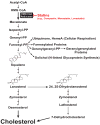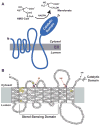Control of cholesterol synthesis through regulated ER-associated degradation of HMG CoA reductase
- PMID: 20482385
- PMCID: PMC2937355
- DOI: 10.3109/10409238.2010.485605
Control of cholesterol synthesis through regulated ER-associated degradation of HMG CoA reductase
Abstract
Multiple mechanisms for feedback control of cholesterol synthesis converge on the rate-limiting enzyme in the pathway, 3-hydroxy-3-methylglutaryl coenzyme A reductase. This complex feedback regulatory system is mediated by sterol and nonsterol metabolites of mevalonate, the immediate product of reductase activity. One mechanism for feedback control of reductase involves rapid degradation of the enzyme from membranes of the endoplasmic reticulum (ER). This degradation results from the accumulation of sterols in ER membranes, which triggers binding of reductase to ER membrane proteins called Insig-1 and Insig-2. Insig binding leads to the recruitment of a membrane-associated ubiquitin ligase called gp78 that initiates ubiquitination of reductase. Ubiquitinated reductase then becomes extracted from ER membranes and is delivered to cytosolic 26S proteasomes through an unknown mechanism that is mediated by the gp78-associated ATPase Valosin-containing protein/p97 and appears to be augmented by nonsterol isoprenoids. Here, we will highlight several advances that have led to the current view of mechanisms for sterol-accelerated, ER-associated degradation of reductase. In addition, we will discuss potential mechanisms for other aspects of the pathway such as selection of reductase for gp78-mediated ubiquitination, extraction of the ubiquitinated enzyme from ER membranes, and the contribution of Insig-mediated degradation to overall regulation of reductase in whole animals.
Figures





Similar articles
-
Feedback regulation of cholesterol synthesis: sterol-accelerated ubiquitination and degradation of HMG CoA reductase.Cell Res. 2008 Jun;18(6):609-21. doi: 10.1038/cr.2008.61. Cell Res. 2008. PMID: 18504457 Free PMC article. Review.
-
Sterol-induced degradation of HMG CoA reductase depends on interplay of two Insigs and two ubiquitin ligases, gp78 and Trc8.Proc Natl Acad Sci U S A. 2011 Dec 20;108(51):20503-8. doi: 10.1073/pnas.1112831108. Epub 2011 Dec 5. Proc Natl Acad Sci U S A. 2011. PMID: 22143767 Free PMC article.
-
Underlying mechanisms for sterol-induced ubiquitination and ER-associated degradation of HMG CoA reductase.Semin Cell Dev Biol. 2018 Sep;81:121-128. doi: 10.1016/j.semcdb.2017.10.019. Epub 2017 Nov 7. Semin Cell Dev Biol. 2018. PMID: 29107682 Free PMC article. Review.
-
Sequential actions of the AAA-ATPase valosin-containing protein (VCP)/p97 and the proteasome 19 S regulatory particle in sterol-accelerated, endoplasmic reticulum (ER)-associated degradation of 3-hydroxy-3-methylglutaryl-coenzyme A reductase.J Biol Chem. 2014 Jul 4;289(27):19053-66. doi: 10.1074/jbc.M114.576652. Epub 2014 May 24. J Biol Chem. 2014. PMID: 24860107 Free PMC article.
-
Gp78, a membrane-anchored ubiquitin ligase, associates with Insig-1 and couples sterol-regulated ubiquitination to degradation of HMG CoA reductase.Mol Cell. 2005 Sep 16;19(6):829-40. doi: 10.1016/j.molcel.2005.08.009. Mol Cell. 2005. PMID: 16168377
Cited by
-
A Phospholipid-Protein Complex from Krill with Antioxidative and Immunomodulating Properties Reduced Plasma Triacylglycerol and Hepatic Lipogenesis in Rats.Mar Drugs. 2015 Jul 16;13(7):4375-97. doi: 10.3390/md13074375. Mar Drugs. 2015. PMID: 26193284 Free PMC article.
-
Update on Mechanisms of Renal Tubule Injury Caused by Advanced Glycation End Products.Biomed Res Int. 2016;2016:5475120. doi: 10.1155/2016/5475120. Epub 2016 Feb 29. Biomed Res Int. 2016. PMID: 27034941 Free PMC article.
-
Cellular compartmentalization of secondary metabolism.Front Microbiol. 2015 Feb 9;6:68. doi: 10.3389/fmicb.2015.00068. eCollection 2015. Front Microbiol. 2015. PMID: 25709603 Free PMC article. Review.
-
Actinidia chinensis Planch root extract inhibits cholesterol metabolism in hepatocellular carcinoma through upregulation of PCSK9.Oncotarget. 2017 Jun 27;8(26):42136-42148. doi: 10.18632/oncotarget.15010. Oncotarget. 2017. PMID: 28178673 Free PMC article.
-
Insulin-induced gene protein (INSIG)-dependent sterol regulation of Hmg2 endoplasmic reticulum-associated degradation (ERAD) in yeast.J Biol Chem. 2013 Mar 22;288(12):8519-8530. doi: 10.1074/jbc.M112.404517. Epub 2013 Jan 10. J Biol Chem. 2013. PMID: 23306196 Free PMC article.
References
-
- Ahner A, Brodsky JL. Checkpoints in ER-associated degradation: excuse me, which way to the proteasome? Trends Cell Biol. 2004;14:474–478. - PubMed
-
- Altmann SW, Davis, Zhu LJ, Yao X, Hoos LM, et al. Niemann-Pick C1 Like 1 Protein Is Critical for Intestinal Cholesterol Absorption. Science. 2004;303:1201–1204. - PubMed
-
- Aridor M. Visiting the ER: The endoplasmic reticulum as a target for therapeutics in traffic related diseases. Advanced Drug Delivery Reviews. 2007;59:759–781. - PubMed
-
- Bartz R, Zehmer JK, Zhu M, Chen Y, Serrero G, et al. Dynamic activity of lipid droplets: protein phosphorylation and GTP-mediated protein translocation 2. J Proteome Res. 2007;6:3256–3265. - PubMed
Publication types
MeSH terms
Substances
Grants and funding
LinkOut - more resources
Full Text Sources
Other Literature Sources
Medical
